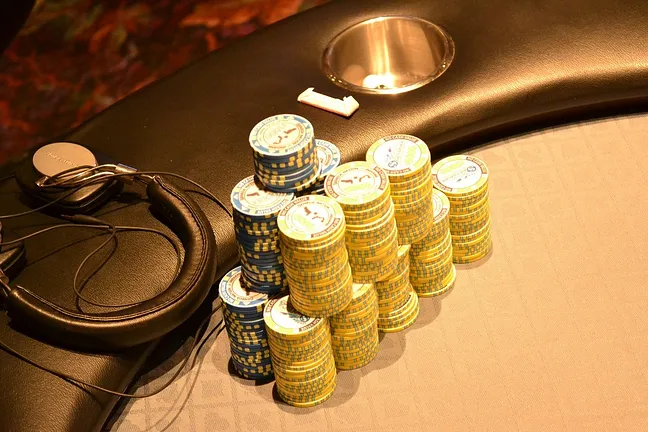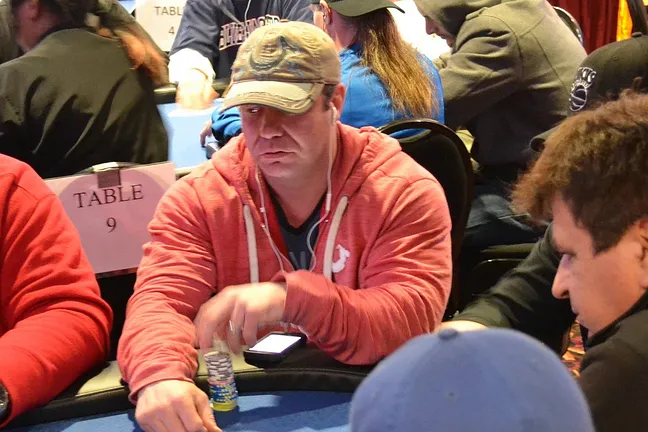With the blinds moving more quickly in today's turbo event, players will need to adjust their play during the later stages of the tournament. We decided to dig into the PokerNews strategy archives and look at some turbo MTT advice from 2011 World Series of Poker November Niner Phil "USCPhildo Collins. Here's some of his interview with PokerNews' Kristy Arnett:
What is the biggest adjustment players need to make to play a turbo if they are used to playing nonturbos?
You need to realize that there will be little to no-flop play after the first couple of levels, and knowing the correct push/fold strategy with less than 15 big blinds or so is crucial.
So for the first couple of levels, are you playing pretty much like you would in other tournaments since the stacks are still fairly deep?
Yes, pretty much. If we start deeper, then I'll go to flops with hands that I would in any other tournament probably, and do the same kind of stuff with how I three-bet or with the hands I want to open.
During the middle stages, how does your hand selection and preflop play change?
It will depend a lot on the stack sizes behind me, and how those players play, but usually I'll be careful not to open light if the other players are in a position to reshove on me.?If there are a few 25 to 35 big blind stacks behind me that are playing kind of tight, then I might open more to steal. Noticing the tendencies of the players behind you is very important when deciding what hands to play.
With aggro players behind you, will you continue to raise and just open up your range for calling a shove? Or in turbos is it better to just open less with those types of players behind you?
It’s a combination of both of those things.?If there are mostly aggro players, then I would open with a tighter range of hands, and I would be more likely to call reshoves with hands like ace-eight. But usually, your table will have a combination of loose and tight players, so it’s important to gather information by observing how they play, so you can have a better idea of who you should be raise/calling and raise/folding against. ?Calling with ace-jack is an easy call against some players, and it’s an easy fold against others.
Absolutely. So deep in a turbo, can you talk about the correct push/fold strategy with less than 15 big blinds you mentioned? What are the general guidelines of the correct way to play this stack late?
In general, the better position you have, the wider you should shove.?If I have 12 big blinds under-the-gun, I might fold ace-right, but I’d shove 12 big blinds on the button with five-three offsuit.?Winning the blinds and antes can add so much to your stack. If you think the couple players behind will only call with a tight range, it’s important not to miss those spots. Fifteen big blinds can actually be a pretty big stack later in a turbo though, and if there are a lot of stacks with 6 to 10 big blinds behind me, I like to shove a lot as well, because they are forced to call off for their tournament life. Even if they think you're doing it wide, they might fold hands like king-jack to stay alive, but I'm building a stack to give myself a better chance to win the tournament, and can afford to lose an all-in without busting. Look for spots where you have fold equity and a hand that plays decent, and don’t be afraid to pull the trigger.
Do you think one of the bigger mistakes people make in turbos is not realizing how quickly they lose fold equity?
I think a lot of bad players think they have fold equity on reshoving incorrectly. If a player is getting 2-to-1, it's going to be correct to call most of the time. So reshoving light when you're opponent has to call is a pretty awful mistake. I think the biggest mistake people make is playing too tight. They miss really easy spots to shove a lot, and that's the most important thing to get right in turbos.
In a spot when it folds around to you on the button or small blind, and you still have decent fold equity, since a shove there "looks" like a steal, should you still pass up that spot to shove with awful hands? Or do you sort of always have to take it when you are at risk of losing fold equity in the next round?
It doesn’t matter if your opponent knows that you're stealing because they simply won’t have a hand to call enough of the time.?Even if you have eight big blinds?in the small blind with three-four offsuit, you should shove because the big blind will have to fold so often. If you have decent fold equity now, definitely take the shove, and that way later, you can fold a hand later like ace-five with your slightly?bigger stack, to avoid getting in crushed, or you can win an even bigger pot of you pick up a real hand.??
![[user153906]](/img/avatars/avatar.svg)


























